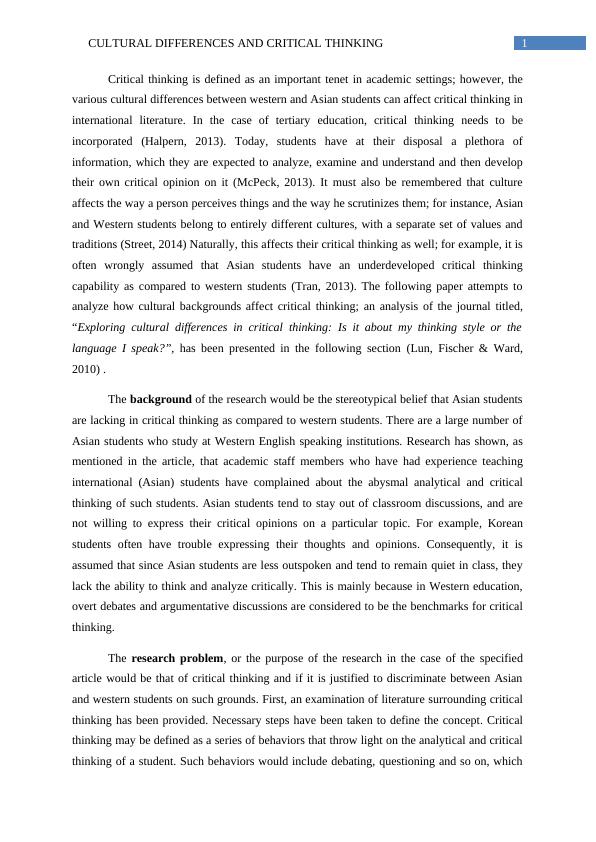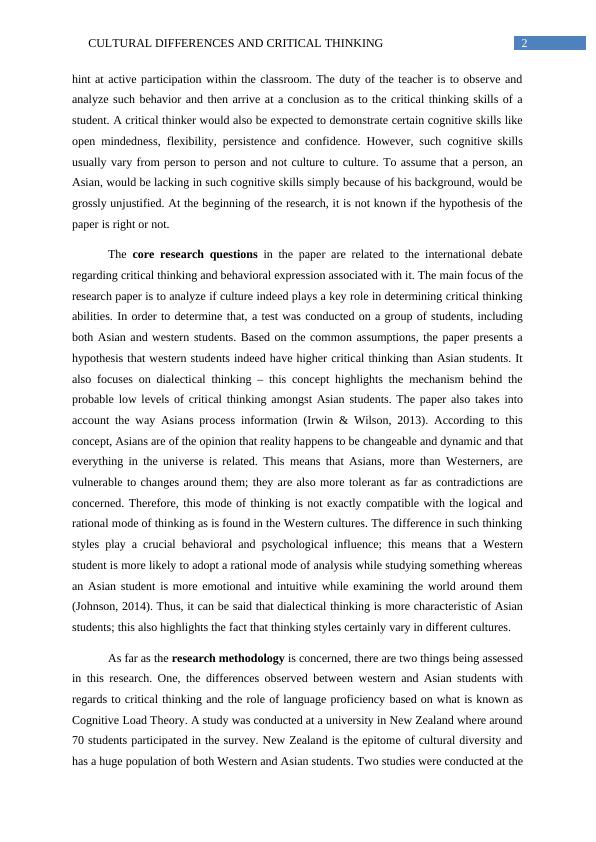(PDF) Exploring cultural differences in critical thinking
6 Pages2236 Words126 Views
Added on 2021-05-30
(PDF) Exploring cultural differences in critical thinking
Added on 2021-05-30
ShareRelated Documents
Running head: CULTURAL DIFFERENCES AND CRITICAL THINKINGCultural differences and critical thinkingName of the student:Name of the university:Author note:

1CULTURAL DIFFERENCES AND CRITICAL THINKINGCritical thinking is defined as an important tenet in academic settings; however, thevarious cultural differences between western and Asian students can affect critical thinking ininternational literature. In the case of tertiary education, critical thinking needs to beincorporated (Halpern, 2013). Today, students have at their disposal a plethora ofinformation, which they are expected to analyze, examine and understand and then developtheir own critical opinion on it (McPeck, 2013). It must also be remembered that cultureaffects the way a person perceives things and the way he scrutinizes them; for instance, Asianand Western students belong to entirely different cultures, with a separate set of values andtraditions (Street, 2014) Naturally, this affects their critical thinking as well; for example, it isoften wrongly assumed that Asian students have an underdeveloped critical thinkingcapability as compared to western students (Tran, 2013). The following paper attempts toanalyze how cultural backgrounds affect critical thinking; an analysis of the journal titled,“Exploring cultural differences in critical thinking: Is it about my thinking style or thelanguage I speak?”, has been presented in the following section (Lun, Fischer & Ward,2010) . The background of the research would be the stereotypical belief that Asian studentsare lacking in critical thinking as compared to western students. There are a large number ofAsian students who study at Western English speaking institutions. Research has shown, asmentioned in the article, that academic staff members who have had experience teachinginternational (Asian) students have complained about the abysmal analytical and criticalthinking of such students. Asian students tend to stay out of classroom discussions, and arenot willing to express their critical opinions on a particular topic. For example, Koreanstudents often have trouble expressing their thoughts and opinions. Consequently, it isassumed that since Asian students are less outspoken and tend to remain quiet in class, theylack the ability to think and analyze critically. This is mainly because in Western education,overt debates and argumentative discussions are considered to be the benchmarks for criticalthinking. The research problem, or the purpose of the research in the case of the specifiedarticle would be that of critical thinking and if it is justified to discriminate between Asianand western students on such grounds. First, an examination of literature surrounding criticalthinking has been provided. Necessary steps have been taken to define the concept. Criticalthinking may be defined as a series of behaviors that throw light on the analytical and criticalthinking of a student. Such behaviors would include debating, questioning and so on, which

2CULTURAL DIFFERENCES AND CRITICAL THINKINGhint at active participation within the classroom. The duty of the teacher is to observe andanalyze such behavior and then arrive at a conclusion as to the critical thinking skills of astudent. A critical thinker would also be expected to demonstrate certain cognitive skills likeopen mindedness, flexibility, persistence and confidence. However, such cognitive skillsusually vary from person to person and not culture to culture. To assume that a person, anAsian, would be lacking in such cognitive skills simply because of his background, would begrossly unjustified. At the beginning of the research, it is not known if the hypothesis of thepaper is right or not. The core research questions in the paper are related to the international debateregarding critical thinking and behavioral expression associated with it. The main focus of theresearch paper is to analyze if culture indeed plays a key role in determining critical thinkingabilities. In order to determine that, a test was conducted on a group of students, includingboth Asian and western students. Based on the common assumptions, the paper presents ahypothesis that western students indeed have higher critical thinking than Asian students. Italso focuses on dialectical thinking – this concept highlights the mechanism behind theprobable low levels of critical thinking amongst Asian students. The paper also takes intoaccount the way Asians process information (Irwin & Wilson, 2013). According to thisconcept, Asians are of the opinion that reality happens to be changeable and dynamic and thateverything in the universe is related. This means that Asians, more than Westerners, arevulnerable to changes around them; they are also more tolerant as far as contradictions areconcerned. Therefore, this mode of thinking is not exactly compatible with the logical andrational mode of thinking as is found in the Western cultures. The difference in such thinkingstyles play a crucial behavioral and psychological influence; this means that a Westernstudent is more likely to adopt a rational mode of analysis while studying something whereasan Asian student is more emotional and intuitive while examining the world around them(Johnson, 2014). Thus, it can be said that dialectical thinking is more characteristic of Asianstudents; this also highlights the fact that thinking styles certainly vary in different cultures. As far as the research methodology is concerned, there are two things being assessedin this research. One, the differences observed between western and Asian students withregards to critical thinking and the role of language proficiency based on what is known asCognitive Load Theory. A study was conducted at a university in New Zealand where around70 students participated in the survey. New Zealand is the epitome of cultural diversity andhas a huge population of both Western and Asian students. Two studies were conducted at the

End of preview
Want to access all the pages? Upload your documents or become a member.
Related Documents
Exploring Cultural Differences in Critical Thinking: Is it About My Thinking Style or the Language I Speak?lg...
|8
|2004
|367
Cognitive Load Theory to Collaborative Cognitivelg...
|9
|2300
|23
Different Viewpoints of Creativity and Innovation in East and West Asian Cultureslg...
|8
|2195
|453
Critical Thinkinglg...
|6
|1421
|113
Evidence Based Nursing Research: A Critical Analysis of Qualitative and Quantitative Approacheslg...
|9
|2265
|290
Introduction to Literacy in Early Childhood ECE6004lg...
|9
|2313
|32
